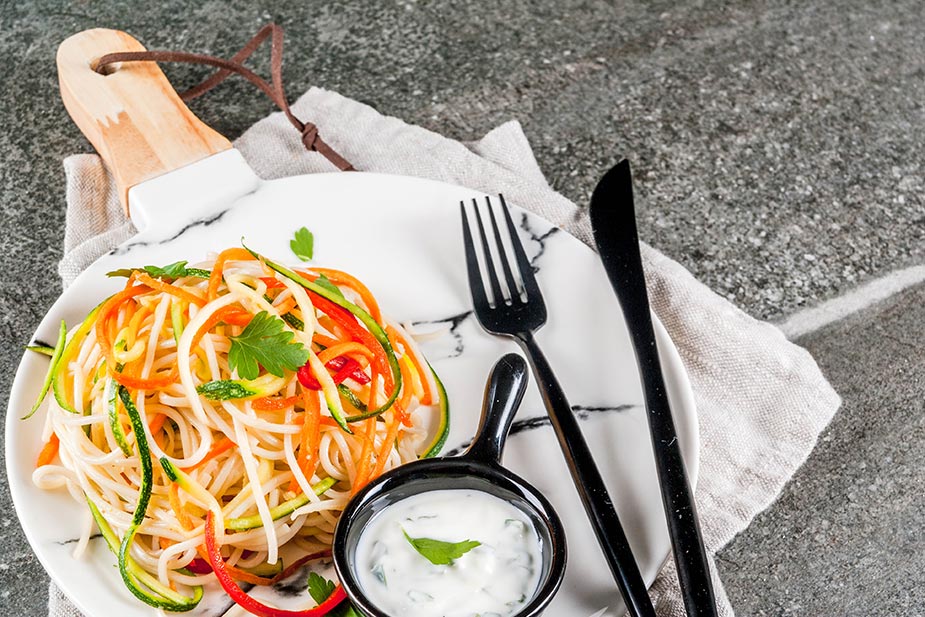Are you tired of the same old low-carb, high-protein diets? Look no further than the Spaghetti Diet – a delicious and satisfying way to shed a few pounds. But wait, you might be thinking, isn’t pasta a big no-no when it comes to weight loss? Not necessarily, as long as you choose the right type of pasta and prepare it with healthy toppings.
Say goodbye to boring diets and hello to the Spaghetti Diet!
Spaghetti Diet Basics
To start the Spaghetti Diet, you’ll need to choose spaghetti made from durum wheat, as it’s a healthier and more filling option. Cook the pasta according to the package directions, but here’s the catch: you must pair it with a vegetable sauce. No meat or cheese allowed on this diet!
To make the sauce, sauté diced zucchini in 2.5 dl of tomato puree for a few minutes. Thicken the sauce with a teaspoon of corn flour and add your favorite dry herbs like oregano. Pour the sauce over the cooked spaghetti, sprinkle with chopped parsley, and drizzle with a tablespoon of extra-virgin olive oil (like in the Mediterranean Diet).
You can enjoy this meal twice a day for lunch and dinner, and you can have as much as you want, as long as you don’t overeat. Of course, it’s recommended to follow a well-rounded meal plan, like the sample one below.
Sample Meal Plan
Breakfast:
- Soft-boiled egg with toast and coffee/tea
- Chicken breast, a few crackers, and freshly squeezed orange juice
- Bowl of oatmeal cooked with water, mashed banana, and cinnamon
Snack:
- Piece of fruit or a glass of fresh fruit and/or vegetable juice
Lunch:
- Spaghetti with vegetable sauce and a large salad made of seasonal vegetables
Snack:
- Piece of fruit
Dinner:
- Tuna and vegetable salad or
- Baked chicken breast with a large salad dressed with olive oil or
- Steamed turkey with steamed vegetables
During the Spaghetti Diet, avoid processed snacks, sweets, and sugary drinks. You can drink freshly squeezed juice, but make it yourself and drink it immediately after squeezing.
Here’s a sample 3-day meal plan for the Spaghetti Diet:
Day 1:
- Breakfast: Bowl of oatmeal with banana and cinnamon.
- Snack: Apple slices.
- Lunch: Spaghetti with vegetable sauce and a side salad with mixed greens, cucumber, and tomato.
- Snack: Carrots and hummus.
- Dinner: Grilled chicken breast with steamed broccoli and brown rice.
Day 2:
- Breakfast: Scrambled eggs with spinach and whole wheat toast.
- Snack: Greek yogurt with berries.
- Lunch: Spaghetti with vegetable sauce and a side salad with mixed greens, peppers, and onion.
- Snack: Almonds.
- Dinner: Baked salmon with roasted sweet potato and green beans.
Day 3:
- Breakfast: Avocado toast with a side of fruit.
- Snack: Sliced bell pepper.
- Lunch: Spaghetti with vegetable sauce and a side salad with mixed greens, carrot, and radish.
- Snack: Cheese stick.
- Dinner: Turkey meatballs with zucchini noodles and marinara sauce.
Pros of Spaghetti Diet
- Simple and easy to follow: The Spaghetti Diet is easy to understand, simple to follow, and doesn’t require any complicated meal plans or calorie counting.
- Satisfying and filling: Pasta is a satisfying and filling food that can help you feel full for longer, reducing the urge to snack between meals.
- Provides necessary nutrients: Pasta is a good source of carbohydrates, fiber, and some essential nutrients like iron and B vitamins.
- Affordable: Spaghetti is a very affordable food option, making it a great choice for anyone on a budget.
- Improves digestion: The fiber content in spaghetti helps improve digestion and can prevent constipation.
Cons of Spaghetti Diet
- Limited food options: The Spaghetti Diet is restrictive and only allows for spaghetti with vegetable sauce, which can get boring and monotonous after a while.
- High in carbs: Pasta is a high-carbohydrate food, which can cause a spike in blood sugar levels and may not be suitable for people with diabetes or other medical conditions.
- Lacks protein: The Spaghetti Diet doesn’t include any significant sources of protein, which is essential for maintaining muscle mass and keeping you feeling full.
- May lead to nutrient deficiencies: A diet based solely on pasta and vegetables may lead to nutrient deficiencies if not carefully planned, as it lacks some essential nutrients found in other food groups.
- Short-term solution: The Spaghetti Diet is only meant to be followed for a short period of time and isn’t a sustainable long-term solution for weight loss or healthy eating habits.
Final Thoughts
The Spaghetti Diet should only last for seven days, but you can repeat it several times if desired. As for results, expect to lose around four pounds of excess water weight. But remember, this diet is not recommended for night owls as it may cause drowsiness after meals. To maximize weight loss, consider adding a 30-minute brisk walk to your daily routine.




